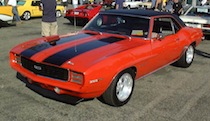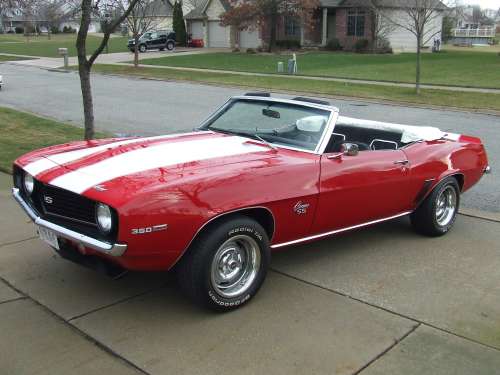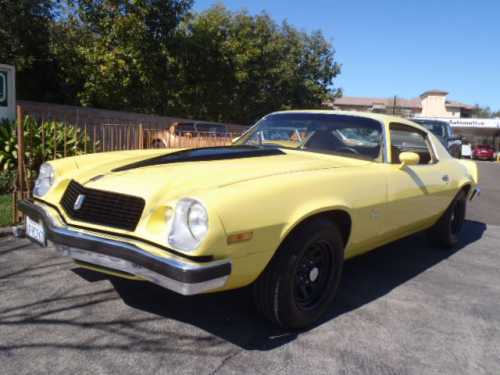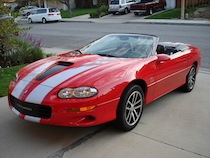
1967 Chevy Camaro
In the late 1950s the American Motors (AMC) American and Studebaker Lark were designed to meet the challenge of the Volkswagen Beetle by being both affordable to the masses and economical to drive. The success of those now classic cars prompted rivals Ford, Chrysler and General Motors (GM) to meet the challenge with the Ford Falcon, Dodge Dart and Chevrolet Corvair. Then in the early 1960s Ford introduced the Mustang and GM responded with the Chevy II. While the early Mustangs and Chevy II's were designed for economy the Corvair was destined to be fun and sporty. However it was discontinued shortly when Ralph Nader attacked it in his book Unsafe at Any Speed.
After the Corvair's demise GM decided to put a new body on the Chevy II chassis with a small block V-8 and called it a "Camaro". Ford Responded by upgrading the Mustang to a similar V-8 and then GM came back with a big block V-8 and the race for muscle car supremacy was on, resulting in the AMC Javelin, Dodge Challenger, Mercury Cougar, Plymouth Barracuda and Pontiac GTO.
The early Camaro classic cars were actually a mish-mash of parts from the Chevy II and other vehicles. The engine sat on a typical ladder frame but from there back it was a uni-body. It had a Chevelle style double-wishbone front suspension, Chevy II single-leaf springs in the rear and the long hood and short rear deck was similar to Ford's classic Mustang "Pony Car". Henry Haag led the design team and included touches from the Corvair, Biscayne and Corvette. The front seats were buckets and the back had a narrow bench that worked best for small people on short trips. You could buy the Camaro with a variety of extras, such as a three or four-speed manual transmission or a two-speed Powerglide automatic.

1969 Chevrolet Camaro SS
The Camaro came to be a true "classic car" with the 1967 model that featured an optional 350 cubic inch V-8 that could go from zero to 60 mph in under eight seconds and it was a big hit, selling more than 220,000 units the first year. In the following years it was adopted by a variety of professional race car drivers and performance was continuously upgraded to meet the desires of young drivers. However by the 1990s the Camaro's popularity was diminishing and production was temporarily halted in 2002.

1974 Chevrolet Camaro
There were five generations of the Chevrolet Camaro. The first was built for the 1967 through 1969 model years as a 2-door coupe or convertible with a variety of straight six and V-8 engines available. The second generation was built between 1970 and 1981 and had the same F-body sub-frame design but was larger and wider. These two generations were known as "Pony Cars" for their resemblance to the Mustang. Modest cosmetic upgrades were introduced in 1974 and 1978 and Road & Track magazine selected the 1971 SS350 model as one of the ten best cars in the world. Z28 packages came and went during those years based on demand and the 1977 model was the first to outsell Ford's Mustang.

2002 Chevrolet Camaro
The third generation Camaro was sold during the 1982 through 1992 model years and was the first to offer fuel injection, five-speed manual and four-speed automatic transmissions. They also featured hatch back bodies for the first time and were also 500 pounds lighter than previous models. The IROC-Z model came out in 1985 and the ILE performance packaged debuted in 1988. Both featured special high performance engines and matching transmission options. The fourth generation Camaro was introduced in 1993 and lasted through the 2002 model year. It got a revised F-body and the Z28 became the popular performance model, eventually getting a 305 cubic engine aluminum engine.

2010 Chevrolet Camaro
As with all performance cars of the Muscle Car Era the pollution control laws that were introduced in the early 1970s put a damper on sales but the Camaro hung on until 2002 when it was discontinued. But then in 2006 a fifth generation concept Camaro went into production and became available for the 2010 model year. The SS model featured a 376 cubic inch engine that put out 426 horsepower and could be coupled with either a six-speed manual or automatic transmission. The 2010 Camaro received the World Car Design of the Year award. The 2011 SS Model received new suspension and engine options, including a supercharged V-8 that produced 580 horsepower. The Chevrolet Camaro is still in production today and still considered a true classic car.



